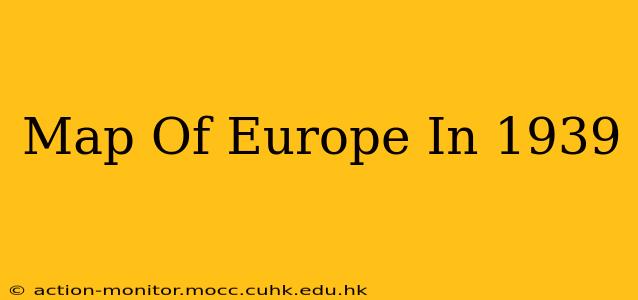The year 1939 stands as a pivotal moment in European history, a year poised precariously on the brink of global conflict. Understanding the political landscape of that time requires examining the map of Europe as it existed then. It wasn't simply a geographical representation; it was a complex tapestry woven with threads of ambition, aggression, and simmering tensions that would soon erupt into World War II.
The Shifting Sands of Power
The map of Europe in 1939 reflected the significant territorial changes brought about by the aggressive expansionist policies of Nazi Germany and the Fascist regimes in Italy and Spain. Gone were the seemingly stable borders of the post-World War I era, replaced by a landscape reshaped by force.
Germany's Expansion:
Germany, under Adolf Hitler, had already annexed Austria (Anschluss) and the Sudetenland region of Czechoslovakia. These actions, achieved through a combination of diplomatic maneuvering and military threat, significantly altered the geopolitical balance, giving Germany a substantial strategic advantage. Poland, now surrounded by increasingly hostile powers, found itself in a vulnerable position.
Italy's Ambitions:
Italy, under Benito Mussolini, had also engaged in territorial expansion, occupying Albania in 1939, furthering its expansionist ambitions in the Balkans. This move further destabilized the region and heightened tensions throughout Europe.
The Soviet Union's Influence:
The Soviet Union, under Joseph Stalin, had its own sphere of influence, particularly in Eastern Europe. While not directly involved in the immediate prelude to the war, the Soviet Union's role would become increasingly crucial in the unfolding conflict.
The Axis Powers Take Shape:
The map also visually demonstrated the growing alliance between Germany and Italy, known as the Axis powers. This alliance, characterized by shared expansionist goals and a common disdain for democratic principles, presented a formidable challenge to the remaining democracies of Europe. The Pact of Steel, signed in 1939, cemented this partnership, forming a powerful bloc.
The Uncertain Future:
The map of Europe in 1939 presented a stark picture: a continent divided, teetering on the precipice of war. The aggressive actions of the Axis powers, coupled with the appeasement policies adopted by some nations, created a volatile situation that would lead to the outbreak of World War II just a few short months later. The map, therefore, becomes a powerful visual representation of the failed attempts at diplomacy and the looming catastrophe that would engulf Europe. Examining this historical map offers a crucial insight into the events that led to one of the most devastating conflicts in human history.
